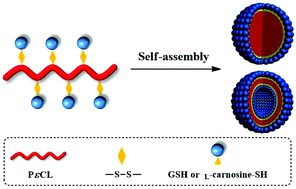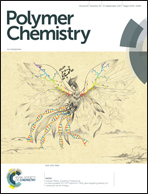Poly(ε-caprolactone) with pendant natural peptides: an old polymeric biomaterial with new properties†
Abstract
The bio-functionalization of poly(ε-caprolactone) (PεCL) provides an approach to broaden the applications of the polymer in medical and biological engineering fields. In this research, PεCL with pendant glutathione (GSH) or L-carnosine was synthesized by a combination of ring-opening copolymerization, Cu(I)-catalyzed Huisgen 1,3-dipolar cycloaddition reaction (click reaction) and thiol-disulfide exchange reaction. The ring-opening copolymerization of εCL and α-chloro-ε-caprolactone (αCl-εCL) was employed in the synthesis of the PεCL-co-P(αCl-εCL) copolymer. The pendent chlorides were converted into azides by a reaction with sodium azide. N-Hydroxysuccinimide (NHS) groups were introduced into the polymer backbones by the click reaction. PεCL with pendant pyridyl disulfide groups was prepared by a reaction of N-hydroxysuccinimide (NHS) activated ester and pyridine dithioethylamine. Peptide modified PεCL were synthesized by thiol-disulfide exchange reactions between thiol groups on GSH (or thiol-modified L-carnosine) and the pendant pyridyl disulfide groups on the polymer chains. The synthesized copolymers were analyzed by size exclusion chromatography, FTIR, 1H NMR and differential scanning calorimetry. The bio-graft copolymers are able to self-assemble into micelles or vesicles in aqueous solutions, depending on the pH values of the solutions. The assembled structures formed by the bio-graft copolymers in aqueous solutions are essentially nontoxic toward MCF-7 and COS-7 cells. The functionalization of the peptide-stabilized assembled structures with lysozyme was also investigated in this research.



 Please wait while we load your content...
Please wait while we load your content...